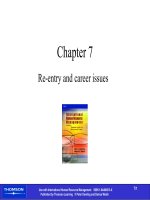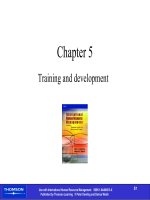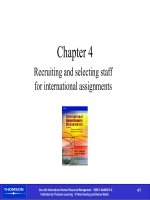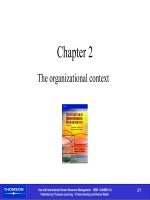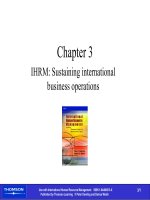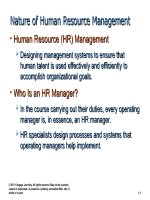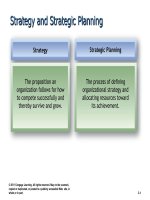Ch016 international human resource management cengage
Bạn đang xem bản rút gọn của tài liệu. Xem và tải ngay bản đầy đủ của tài liệu tại đây (832.71 KB, 23 trang )
Nature of Unions
• Union
A formal association of workers that promotes the
interests of its members through collective action.
• Why Employees Unionize
They are dissatisfied with how they are treated by
their employers.
They believe that unions can improve their work
situations.
© 2011 Cengage Learning. All rights reserved. May not be scanned,
copied or duplicated, or posted to a publicly accessible Web site, in
whole or in part.
16–1
FIGURE 16–1
Factors Leading to Employee Unionization
© 2011 Cengage Learning. All rights reserved. May not be scanned,
copied or duplicated, or posted to a publicly accessible Web site, in
whole or in part.
16–2
Nature of Unions (cont’d)
• Why Employers Resist Unions
Unionization constrains what managers can and
cannot do in a number of areas.
Unionization can result in higher wages and benefits.
© 2011 Cengage Learning. All rights reserved. May not be scanned,
copied or duplicated, or posted to a publicly accessible Web site, in
whole or in part.
16–3
FIGURE 16–2
Union Membership as a Percentage
of the U.S. Civilian Workforce
Source: U.S. Department of Labor, Bureau of Labor Statistics, 2010.
© 2011 Cengage Learning. All rights reserved. May not be scanned,
copied or duplicated, or posted to a publicly accessible Web site, in
whole or in part.
16–4
Unions Globally
• Union membership is falling in advanced
countries.
High unemployment is creating pressure for change.
• In some countries, unions are closely tied to
political parties.
• Child labor is an issue in some countries.
• Co-determination
A practice whereby union or worker representatives
are given positions on a firm’s board of directors.
© 2011 Cengage Learning. All rights reserved. May not be scanned,
copied or duplicated, or posted to a publicly accessible Web site, in
whole or in part.
16–5
U.S. and Global Differences in
Union-Management Relations
Key
Differences
Focus on
Economic
Issues
Organization
by Job and
Employer
© 2011 Cengage Learning. All rights reserved. May not be scanned,
copied or duplicated, or posted to a publicly accessible Web site, in
whole or in part.
Collective
Agreements as
“Contracts”
Competitive
Relations
16–6
Reasons for U.S. Union Membership
Decline
Causes of Membership Decline
Geographic
Changes
Industrial
Changes
© 2011 Cengage Learning. All rights reserved. May not be scanned,
copied or duplicated, or posted to a publicly accessible Web site, in
whole or in part.
Workforce
Changes
16–7
FIGURE 16–3
Union Membership by Industry
© 2011 Cengage Learning. All rights reserved. May not be scanned,
copied or duplicated, or posted to a publicly accessible Web site, in
whole or in part.
Source: U.S. Department of Labor, Bureau of Labor Statistics, 2010.
16–8
Union Targets for Membership Growth
Focus of Union Organizing
Health Care
Professionals
Low-Skill
Workers and
Immigrants
© 2011 Cengage Learning. All rights reserved. May not be scanned,
copied or duplicated, or posted to a publicly accessible Web site, in
whole or in part.
Contingent and
Part-Time
Workers
16–9
Union Structure
• Craft Union
A union whose members do one type of work, often
using specialized skills and training.
• Industrial Union
A union that includes many persons working in the
same industry or company regardless of jobs held.
• Federation
A group of autonomous national and international
unions.
• National and International Unions
Groups of local union units
© 2011 Cengage Learning. All rights reserved. May not be scanned,
copied or duplicated, or posted to a publicly accessible Web site, in
whole or in part.
16–10
Union Structure (cont’d)
• Local Union
A union centered around either a particular employer
or a particular geographic location.
• Business Agent
A full-time union official who operates the union office
and assists union members.
• Union Stewart
An employee elected by local members to serve as
the first-line representative of unionized employees.
© 2011 Cengage Learning. All rights reserved. May not be scanned,
copied or duplicated, or posted to a publicly accessible Web site, in
whole or in part.
16–11
FIGURE 16–4
Major National Labor Laws
© 2011 Cengage Learning. All rights reserved. May not be scanned,
copied or duplicated, or posted to a publicly accessible Web site, in
whole or in part.
16–12
Employer Unfair Labor Practices
• Interfering with the organizing and collective
bargaining rights of employees.
• Dominating or interfering with any labor
organization.
• Encouraging or discouraging membership in a
particular union.
• Discharging persons for organizing activities or
union membership.
• Refusing to bargain collectively.
© 2011 Cengage Learning. All rights reserved. May not be scanned,
copied or duplicated, or posted to a publicly accessible Web site, in
whole or in part.
16–13
Taft-Hartley (Labor-Management Relations) Act
• Right-to-Work Laws
State laws that prohibit contracts requiring employees to join
unions to obtain or continuing employment.
Types of
Shops
Closed Shop
Union Shop
© 2011 Cengage Learning. All rights reserved. May not be scanned,
copied or duplicated, or posted to a publicly accessible Web site, in
whole or in part.
Agency Shop
Maintenanceof-Membership
Shop
16–14
FIGURE 16–5
Right-to-Work States
© 2011 Cengage Learning. All rights reserved. May not be scanned,
copied or duplicated, or posted to a publicly accessible Web site, in
whole or in part.
16–15
FIGURE 16–6
Typical Unionization
Process
© 2011 Cengage Learning. All rights reserved. May not be scanned,
copied or duplicated, or posted to a publicly accessible Web site, in
whole or in part.
16–16
Organizing Campaign
Holding mandatory
employee meetings.
Employers’ Union
Prevention Efforts
Distributing anti-union
leaflets and letters
Anti-union videos, e-mails,
and other electronic means.
© 2011 Cengage Learning. All rights reserved. May not be scanned,
copied or duplicated, or posted to a publicly accessible Web site, in
whole or in part.
16–17
Unions’ Organizing Efforts
Authorization
Cards
Salting
Unionization
Efforts
Contract
Negotiation
Bargaining Unit
Composition
Certification
and
Decertification
© 2011 Cengage Learning. All rights reserved. May not be scanned,
copied or duplicated, or posted to a publicly accessible Web site, in
whole or in part.
16–18
Collective Bargaining Issues
Management Rights
Bargaining
Issues
Union Security
(dues checkoff)
Classification of
Bargaining Issues
© 2011 Cengage Learning. All rights reserved. May not be scanned,
copied or duplicated, or posted to a publicly accessible Web site, in
whole or in part.
16–19
FIGURE 16–8
Weekly Earnings of
Union and Nonunion
Workers
Source: Bureau of Labor Statistics, “Union Members Summary,”
January 22, 2010.
© 2011 Cengage Learning. All rights reserved. May not be scanned,
copied or duplicated, or posted to a publicly accessible Web site, in
whole or in part.
16–20
FIGURE 16–9
Typical Items in a Labor Agreement
1.
Purpose of agreement
11. Separation allowance
2.
Non-discrimination clause
12. Seniority
3.
Management rights
13. Bulletin boards
4.
Recognition of the union
14. Pension and insurance
5.
Wages
15. Safety
6.
Incentives
16. Grievance procedure
7.
Hours of work
17. No-strike or lockout clause
8.
Vacations
18. Definitions
9.
Sick leave and leaves of
absence
19. Terms of contract (dates)
20. Appendices
10. Discipline
© 2011 Cengage Learning. All rights reserved. May not be scanned,
copied or duplicated, or posted to a publicly accessible Web site, in
whole or in part.
16–21
Strikes
Unfair
Labor Practice
Strikes
Economic
Strikes
Types of
Strikes
Sympathy
Strikes
Wildcat
Strikes
Jurisdictional
Strikes
© 2011 Cengage Learning. All rights reserved. May not be scanned,
copied or duplicated, or posted to a publicly accessible Web site, in
whole or in part.
16–22
Grievance Management
• Complaint
Indication of employee dissatisfaction
• Grievance
A complaint formally stated in writing
• Grievance Procedures
Formal channels used to resolve grievances
Union
representation (Weingarten) rights
• Grievance Arbitration
Means by which a third party settles disputes arising
from different interpretations of a labor contract.
© 2011 Cengage Learning. All rights reserved. May not be scanned,
copied or duplicated, or posted to a publicly accessible Web site, in
whole or in part.
16–23


